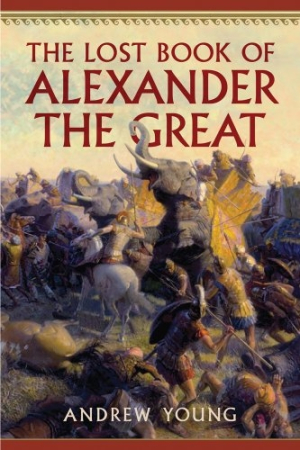The Lost Book of Alexander the Great
From a historical standpoint, Young proves himself to be a diligent, devoted historian who has carefully woven together multiple narratives.
Recreating a lost book from the third century BC is an ambitious task, one that Andrew Young earnestly attempts in The Lost Book of Alexander the Great. With “a little bit of literary forensics,” he pieces together citations from later manuscripts that reference Ptolemy’s History. The presumed author, Ptolemy Lagides, was one of Alexander’s “closest friends and most trusted generals” in the Macedonian army, and if it had survived, many historians believe his book would have been the most accurate firsthand account of the conquests of Alexander the Great.
The story begins with Alexander’s quest to reestablish control over the Greek city-states his father conquered before his death. With Ptolemy at his side, Alexander proceeds to conquer foreign lands from Greece to India. Young provides comprehensive descriptions of several key battles, including the Battle of Issus, which marked the first significant defeat of Persia; the Siege of Tyre, which lasted seven gruesome months; and the Battle of the Hydaspes River, which provided the West with access to India.
Ptolemy seems to have continually portrayed Alexander as great, glorious, and worthy of envy in his writings. As Young repeatedly reminds the reader, the reason he was “undoubtedly biased toward showing Alexander in a positive light” was because he credited Alexander with his own successes later in life.
After Alexander’s death, Ptolemy gained control of Egypt and crowned himself king. Thus, while Ptolemy’s History chronicles Alexander’s conquests, it also “seems to tell us something of its author, Ptolemy, and something of the Hellenization that followed Alexander’s conquests.” In Ptolemy’s presumed description of the destruction of the palace at Persepolis, for instance, he claims that Alexander was responsible for burning it down, while many other ancient sources indicate that a courtesan, Thais, was the instigator. “Ptolemy had good reasons to not set that down in his book,” explains Young. “It would stain the reputation of Alexander and his men, Ptolemy included, and it would place the blame on Thais, who would be Ptolemy’s wife. While Ptolemy might attempt to be accurate in his narrative, it would be in his best interests to gloss over this part of the story.” To spare himself, his wife, and their three children, Ptolemy might have changed some of the details in his book. Despite some small discrepancies, however, Young believes that Ptolemy’s History “is still not a true depiction, but it is possibly as close to the truth as we are likely to get.”
While Young’s mission to recreate Roman-era narratives about Alexander the Great may not immediately appeal to all readers, his systematic reconstruction is entertaining and easy to read. His attempt to uncover the truth by “removing the Roman veil” is honorable and well executed. This book offers surprising insights into a great historical figure about which it seems so much, yet so little, is actually known.
Reviewed by
Jacquelyn Lazo
Disclosure: This article is not an endorsement, but a review. The publisher of this book provided free copies of the book to have their book reviewed by a professional reviewer. No fee was paid by the publisher for this review. Foreword Reviews only recommends books that we love. Foreword Magazine, Inc. is disclosing this in accordance with the Federal Trade Commission’s 16 CFR, Part 255.

